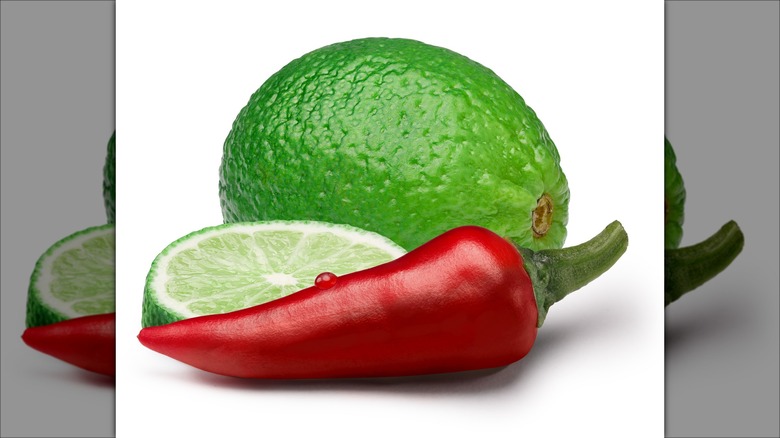What Really Puts The Spice In Tajín Seasoning
Mexico has no shortage of good food. From elotes and equites to salsa and pico de gallo, the cuisine of Mexico is as fresh, vibrant, and rich in flavor as its history and cultural impact. One product, while a relatively recent entrant in the country's cuisine but ubiquitous today, is none other than Tajín seasoning. Tajín, properly known as Tajín Clásico, first hit the market in 1985. It was invented by Mexico native Horacio Fernández, who brought the family recipe to mass market. As Fernández astutely predicted with the product's name, Tajín Clásico became an instant classic, featuring a key component of Mexico's finest flavors — heat.
An essential component of authentic Mexican cuisine, the heat comes from a carefully crafted blend of Mexican chili peppers, including chiles de árbol, guajillo, and pasilla. This chili pepper blend, along with lime powder and sea salt, make a versatile, staple seasoning enjoyed in Mexico and beyond.
The spice and its supporting savor
Chile de árbol, guajillo, and pasilla all bring the heat in Tajín Clásico seasoning, but at different intensities. Chile de árbol is a medium-heat chili pepper (between 15,000 and 30,000 Scoville Heat Units or SHUs) with smoky, earthy undertones, guajillo chiles are sweeter and fruitier in flavor (between 2,500 and 5,000 SHUs, and pasilla chiles (just 1,000 to 2,500 SHUs) marry both the smoky and fruity qualities of the other two.
The chili powder mix certainly pulls its weight in Tajín, but it works in tandem with the sea salt and dehydrated lime juice to deliver the most impactful burst of flavor. The lime flavor gives Tajín its distinct tanginess, which helps create a more robust flavor profile and compliments the spice from the chili mix. The salt activates the tongue's salty taste receptors, further amplifying the flavors of the chili and lime. What's more, the sea salt granules, which tend to be larger than table salt granules, give the seasoning its signature subtle crunch. Together, these ingredients make the overall flavor of Tajín all the more intricate.
Where Tajín shines
The spicy, salty, sour mix that is Tajín Clásico adds the perfect kick to any dish — Mexican or otherwise. There are many ways to utilize this special seasoning, but some of its most popular applications involve sweet foods. For instance, Tajín makes a colorful, zesty, and spicy rim for a margarita or michelada. It also adds a zesty pop of flavor to fruit salads or plain watermelon, pineapple, and mango slices. As for more savory foods, Tajín adds the perfect kick to corn on the cob, roasted mixed nuts, and grilled meats. The options certainly do not stop there, though. Tajín's flavoring potential is as strong as the flavor itself.
Whether you season sparingly or generously, Tajín packs a perfect punch every time. It offers a lively burst of flavors that would appeal to anyone who appreciates lively food and can handle its agreeable heat.


